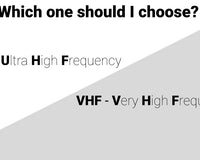Updated: O8/2021
When you make the decision to begin shopping for two way radios, you're probably thinking, "How hard can this be? I need a device that will send my voice to another device where someone I know is listening to my message." While your not wrong in this thinking, the paths and turning points of which can change the entirety of your network can become daunting very quickly. This article is here to help you begin that journey with a base of knowledge already under your belt helping you be more definitive in what you are looking for, and therefore less bogged down by crossroads you encounter on your journey. The question is, which door do you choose?
There are three types of portable radios typically employed in the U.S. by the public: Family Radio Service (FRS), General Mobile Radio Service (GMRS), and Land Mobile Radios (LMR). If your new to this radio game, knowing the difference between these can literally save you time, money, and future headaches.
This article focuses on outlining the differences and requirements for FRS, GMRS, and LMR radio services. For information regarding obtaining a license for GMRS or LMR use, check out this article where we discuss those options further.
FRS vs. GMRS vs. LMR
In the simplest terms, FRS is free to operate while both GMRS and LMR require an FCC license to utilize.
These 3 sectors also differ in the end user they have been tailored for. FRS walkie talkies are meant for the amateur individual who generally only needs a relatively short distance push-to-talk solution. GMRS two way radios are employed by more savvy users, but are still geared toward the individual, or in some cases a very small business with no need for communication advancement. LMR devices are designed for business organizations or public safety organizations. They are meant to advance with your companies' needs, being broader coverage or better technology integration in the future, and are by far the most secure communication method of the 3.
There are several more differences between each of these three radio sectors, which we will discuss below, but another glaringly obvious difference in FRS, GMRS, and LMR's is the quality of the devices themselves. FRS and GMRS are considered "low-end" models, while LMR's are the "high-end" with devices that are more rugged and powerful with access to to greater technological abilities.
Since you pay for private frequencies used by a radio operating in GMRS and LMR, you’re given channel security. Frequencies utilized by walkie talkies operating on the FRS are free but will not be as secure, as they are open to all other FRS users.
The FCC has authorized the FRS 22 channels within a band of frequencies shared with GMRS. The frequencies are between 462 and 467 MHz. Whether you can operate your radio in either service is determined by the specs of your walkie talkie and how you plan to use it.
LMR devices are typically all already over the power threshold set by the FCC, requiring them to utilize private frequency licensing no matter what. Your radios designed for LMR use will be capable of using either Very High Frequency bands (VHF) or Ultra High Frequency bands (UHF). The FCC has given permission for LMR's to use frequencies in the 30-50 MHz (Low VHF Band), 150-172 MHz (High VHF Band), 450-470 MHz (UHF Band), and also some frequencies in the 800 & 900 MHz bands (UHF). This means you can tailor the frequencies your radio systems operate in based on the needs of your situation.
Family Radio Service (FRS)
The general public is most familiar with radios utilizing FRS, as they are the ones you most often come across in big box stores and online retailers like Amazon. They come ready to operate right out of the box and are typically utilized for outdoor leisure activities, i.e. hunting, hiking, mountain sports, etc. These are usually small walkie talkies that do not offer much in the way of customization, if any.
If you are going to be using your walkie talkies for close range, within 1-2 miles depending on terrain, the Family Radio Service will work great for you. The FRS has limitations for how powerful your radios can be in order to use it, 2 watts max output capacity, making it great for most amateur uses but due to the limited power output, the range of the radios you use are set.
The FCC also does not allow for users of the FRS to use repeaters or signal boosters that could amplify a radio's range. If you find yourself in need of more range or are in a dense area that is impeding your signal, you will have to consider upgrading to a more powerful two way radio that utilized the GMRS.

Above is a visual representation of the frequency bands and channels shared by the FRS and GMRS. Notice the “piano tiles” below the solid orange boxes? These shaded and white tiles represent the areas the FRS is authorized to share with the licensed GMRS users.
You also might have noticed that the white tiles are only completed on the left half of the frequency band. The white tiles in the image are to signify channels where only a 2W FRS radio can send/receive information.
This is significant because the allowance of 2W walkie talkies in the FRS is relatively new. In 2010, the FCC put forth proposals to reshape the FRS and GMRS requirements, and in true governmental form the changes came about in 2017 with the WT Docket No. 10-119 - Part 95 (Personal Radio Service Reform). The Part 95 document is rather dense, but if you want to really know your stuff, give it a read. It will also enlighten you to the vernacular used by the FCC and other government agencies, which never hurts right?
The changes to the FRS were significant because prior to this, an FRS radio was limited to only 0.5 a watt of max output capacity. You might realize how limited that makes the range of your device, especially if you find yourself in a dense area.
The new rules also increased the channels available to the FRS to 22 and allowed for FRS radios to transmit digital data. The allowance of digital data opened the possibility for users to not only transmit voice conversations, but also brief text messages and location information, which can be a great asset depending on the situation.
For a list of great radios you can buy license-free, check out our Best License Free Two Way Radios article. This will give you a breakdown of some wonderful devices you can buy with no worry about obtaining a license and provide specs for each unit.
General Mobile Radio Service (GMRS)
Individuals and small businesses who require a radio with a little more power than FRS, but don't quite need the services offered by LMR devices should gravitate towards the GMRS. The General Mobile Radio Service provides many pros for its sector with virtually the only con being that the FCC requires its users to acquire a license for use.
Note: Walkie talkies that utilize the GMRS will still generally be found in Big Box retailers like their FRS cousins, and DO NOT offer much in the way of frequency/channel customization via programming. For that echelon of communication need, you should really consider an LMR option.
This license is for your own security and the security of all others in the GMRS. Since radios utilizing the GMRS are allowed power outputs over 2W, if there were not designated frequencies for each user, then the amount of interference would be ridiculous. All the individual signals would be powerful enough to interfere with each other and virtually no information would be reasonably secured.
Due to the higher power output of GMRS walkie talkies, they tend to have louder transmissions as well as clearer signals. The stronger signal can penetrate through interfering terrain much more easily than a signal under 2W. Also, with GMRS, users are able to utilize mobile two way radios and signal repeaters that can greatly enhance the power and range of your radios. Your typical handheld GMRS radios will be between 1-5W power output and mobile two way radios are usually 30-50W.
The difference in wattage across devices provides another plus to consumers utilizing the GMRS: customizability to individual use cases. Plus with the addition of mobile radios and repeaters, your entire communication network can be tailored to your needs.
GMRS radios are more customizable frankly because they are more expensive units than those on the FRS. As with most products, as prices are raised, so increases the features one can expect to see. The higher-powered GMRS devices, as well as manufacturer specific features let this sector of two way radios stand above FRS walkie talkies.
The GMRS class of radios also offers much better security than walkie talkies that can operate on the FRS. While FRS radio companies use codes on each channel to help filter out other signals from FRS users, this is by far a system with cracks letting interference occur from time to time. With devices in the GMRS, you are given greater message security because you have been licensed to use a private frequency by the FCC. This provides inherent privacy not available in the FRS. LMR radios offer higher quality security measures such as encrypted security keys, and digital “packing” of your sensitive information.
To learn more about the privacy features available to you with higher-tier radios, check out our blog on Basic vs Enhanced Privacy.
Under Part 95, referenced above for FRS, the GMRS would now also be able to transmit digital data (messages and other info) which before this filing was only granted to Garmin devices through a special waiver. The GMRS would be given 30 channels, 16 main channels, and 14 interstitial channels that would be shared with the FRS. You can see the interstitial channels marked by light orange shading on the channel allotment image below.

Another change brought to the GMRS by Part 95 is the extension of how long your license will be valid. Previously a license term for the GMRS would only last for 5 years, now the licenses are good for 10 years.
Interested in a GMRS license? Follow this link to learn more.
Land Mobile Radio (LMR)
While FRS and GMRS radios are good devices that can fill the needs of a lot of consumers, LMR is where you go for the real deal. Land Mobile Radio systems are the crème-de-la-crème of the radio world short of highly specialized military systems not available to the public, and are the level of devices that we at Radio Depot are licensed to sell.
LMR is utilized by several different industries with needs that vary across the board. This is where most businesses, the industrial sector, and the public safety sector turn for their communication needs.
We've come up through the grades of radio systems. We started with the cheap FRS option that will plainly connect you and someone else. Then moved to GMRS systems that, while are more powerful than FRS and require FCC licensing, are still fairly substandard devices and systems when compared to the top-tier LMR radio services. GMRS radios are limited to one set of frequencies set aside by the FCC, and while they offer privacy over FRS radios, they are still meant more for the private citizen use whose needs simply outweigh what the FRS radios can offer. That’s not to say there aren’t small businesses out there who do make use of GMRS and even FRS radios, but we’ve found the more serious someone is about their communication needs, the greater likelihood they are to choose LMR solutions over the others especially when buying for a business.
LMR systems offer you many benefits over its cheaper cousins, the FRS and GMRS. One upgrade is that Land Mobile Radio systems are much more customizable to your needs. The FCC has allotted several frequency bands in which LMR systems are allowed to operate, with proper licensing of course.
Your radios that are designed for LMR use will be capable of using either Very High Frequency bands (VHF) or Ultra High Frequency bands (UHF). LMR radios are given permission to use frequencies in the 30-50 MHz (Low VHF Band), 150-172 MHz (High VHF Band), 450-470 MHz (UHF Band), as well as in the 800 & 900 MHz bands (UHF). This means you can tailor the frequencies your radio systems operate in based on the needs of your situation.
VHF and UHF transmission frequencies are each going to grant you different abilities with your transmission. The most obvious difference is UHF transmissions are higher frequencies, giving them more inherent power to penetrate through thick building materials and thus travel farther in densely populated areas than VHF frequencies. On the other hand, since VHF transmissions are lower frequencies, their wavelengths are longer. This gives them the advantage over UHF in wide open areas to travel longer distances in being able to better navigate around the horizon. VHF do this because their penetrating power is low enough to be able to reflect off the atmosphere and return to the ground, whereas UHF transmissions will blast right through out into space never to be heard again. For more in-depth differences between VHF and UHF and when to choose which, you should give “UHF vs VHF - Learn about radio frequencies” a read; another source for information would be the Frequency Bands section of our Guide for Everything Two Way Radio.
Like GMRS devices, two way radios operating in the LMR sector also require FCC licensing to authorize the use of your device in any of the above mentioned frequency bands. This may seem off-putting at first glance, but the process of coordinating the proper frequencies for your organization can actually grant more practicality other than the inherent security and licensed frequency will offer.
Since the LMR frequency bands are more extensive and utilized by more complex radio systems, the process for attaining your frequencies is more involved than with GMRS. Because of this, using a frequency coordinator (with whom we have many relationships) is required by the FCC to ensure everything will continue to run smoothly in these designated frequency bands.
It is in this frequency coordination, you are granted another level of customizability not available in either FRS or GMRS. A frequency coordinator will work with you to get you the amount of frequencies you will need and the best ones for your systems based on your use case. Then, in conjunction with the allotted frequencies licensed to you, we can then program your devices in any fashion you would like to fit your desired communication system outcome.
You may want certain channels to be programmed to certain frequencies, or only certain devices to be able to hear specific frequencies, and so on. All of this and more can be accomplished through your talks with us on just how you would like your programming to be. If this is sticking in your brain, you may want to give us a shout for more information regarding what we can do for you.
Frequency use customization is but one option available for you to tailor your LMR system. Another way Land Mobile Radios stand above FRS’ and GMRS’ is the quality of the products involved. Remember, you’ve been brought up through the classes to the top-quality devices. Radios in the LMR class are going to be powerful, with generally 4-5 Watt power output for portable devices, they are generally all at least IP57 rated, meaning the lowest models in this class can stand the test of most work environments, and they support advanced technologies making your network that much more personalized and protected.
Security is PARAMOUNT when it comes to the relaying of a business' sensitive information. LMR devices offer privacy technologies that FRS and GMRS could only dream about. I'm referring back to Basic and Enhanced Privacy here, as well as different transmission technologies manufacturers have utilized in the age of the digital radio. Motorola has coined DMR (Digital Mobile Radio), while ICOM and Kenwood make use of NXDN (Next Generation Digital Narrowband). These technologies utilize different methods for dividing your frequency use up in order to get more out of every one. To learn more about these technologies, check out the "Transmission Types" section of Radio 101.
Additionally, Land Mobile Radio systems have received a number of upgrades in recent years allowing them to be more interoperable, meaning more able to be integrated into existing systems, and more reliable. The bottom line? LMR systems are superior to their cheaper cousins in just about every way, completely justifying their higher price tags for businesses that need instant, secure responses from their team.
After making it this far, can you see why those serious about their communication needs tend to gravitate toward LMR?
Interested in obtaining an LMR license? You can follow this link, contact-us, or call (888)733-7681, to learn more!
Bring it Home
I hope this article provided you a great base layer to grow your radio knowledge from. The details of these radio sectors can quickly feel tedious, but knowing what each can offer is what will really set you up for success when shopping for your next communication network, or improving upon your existing systems.
Please don’t hesitate to get in contact with us with any questions. You can leave a comment below, fill out our contact-us form, or give us a call at (888) 733-7681. We would be happy to help.
As always, if you found this article helpful please share the wealth of knowledge with your friends and family on social!






